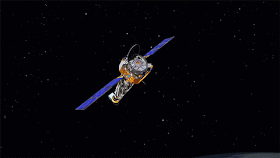ISS - Expedition 53 Mission patch.
Sept. 23, 2017
(Highlights: Week of September 18, 2017) - Crew members on the International Space Station wrapped up a low-temperature combustion investigation that was sparked by a discovery made during a previous run of experiments aboard the orbiting laboratory, and could help scientists develop new engines and fuels that are more efficient and less harmful to the environment.
Image above: The Zero Boil-OFF Tank (ZBOT) on the International Space Station has a large "ullage" bubble and several smaller bubbles around it. The experimental hardware uses an experimental fluid to test active heat removal and forced jet mixing as alternative means for controlling tank pressure for volatile fluids. Image Credit: NASA.
“Cool flames” were first discovered during the Flammability and Extinction (FLEX) study on the space station in 2013. The Cool Flames investigation followed in an effort to better understand this unique burning behavior. The final run of Cool Flames Investigation led to the dismantling and stowing of the hardware, bringing the operations for the study on the space station to a close. Data from the investigation will now be analyzed by Earth scientists. Some types of fuels initially burn very hot, then appear to go out — but they continue burning at a much lower temperature with no visible flames. These phenomena are called cool flames. The Cool Flames Investigation provides new insight into this phenomenon, as well as new data on fire safety in space.
The Advanced Research Thermal Passive Exchange (ARTE) investigation was also completed. This new heat pipe design reduces the weight of thermal systems while also increasing their efficiency. Scientists want to evaluate the performance of the ARTE heat pipes to keep the overall mass low and save on energy. We won’t have to actively cool some areas with a fan, or actively heat other areas. If successful, this highly conductive pipe could be integrated into future spacecraft, aircraft of supercomputer systems on Earth.
Image above: NASA astronaut Randy Bresnik conducts a study into muscle atrophy on the International Space Station. He conducted an ultrasound on his calf muscle while exercising using a mechanism created by ESA. Image Credit: NASA.
As ARTE completed a heating investigation, the Zero Boil-Off Tank (ZBOT) study was working on better ways to regulate cryogenic fluid or gas. Rocket fuel, spacecraft heating and cooling systems and sensitive scientific instruments rely on very cold cryogenic fluids. Heat from the environment around the cryogenic tanks can cause their pressures to rise, which requires releasing or "boiling off" fluid to release the excess pressure, or actively cooling the tanks in some way. ZBOT uses an experimental fluid to test active heat removal to control tank pressure for volatile fluids.
Cryogenic tanks require complicated storage and flow solutions for fluids that act as both liquid and gas, depending on their temperatures. Results from this investigation into phase change and heat transport will provide data that could improve models used to design lightweight, efficient, and long-duration cryogenic storage in space for fuel tanks and engines, but can also help in the development of storage facilities in laboratories and other industries on Earth.
Image above: ESA astronaut Paolo Nespoli works on packing the SpaceX-Dragon cargo craft, which returned to Earth this week, returning a variety of technological and biological research. Image Credit: NASA.
NASA astronaut Randy Bresnik , ESA (European Space Agency) astronaut Paolo Nespoli and Russian cosmonaut Sergey Ryazanskiy participated in research into muscle atrophy in space with the Myotendinous and Neuromuscular Adaptation to Long-term Spaceflight (Sarcolab-3) study involving the Muscle Atrophy Research & Exercise System (MARES). This investigation studies the adaptation and deterioration of the soleus, or calf muscle, where it joins the Achilles tendon, which links it to the heel and carries loads from the entire body. Muscle fiber samples are taken from crew members before and after flight and analyzed for changes in structural or chemical properties. MRI and ultrasound tests and electrode stimulation are conducted to help assess muscle and tendon changes caused by microgravity exposure.
Space to Ground: Busy Crew: 09/22/2017
Video above: NASA's Space to Ground is a weekly update on what is happening on the International Space Station. Social media users can post with #spacetoground to ask questions or make a comment. Video Credit: NASA.
By understanding the mechanisms behind loss of muscle mass in space, scientists can develop countermeasures that are more effective for the crews -- pharmacological, dietary or exercise-based – and maintain or improve the health and performance of astronauts in orbit. Scientists also can gain insight into certain muscular conditions on Earth. Solutions developed for astronauts could be used for rehabilitation of patients with a variety of muscular conditions.
International Space Station (ISS). Image Credit: NASA
Progress was made on other investigations this week, including: Tropical Cyclone, Combustion Integration Rack (CIR), Long Duration Sorbent Testbed (LDST), Marrow, Actiwatch, Dosetracker, ACME, Fine Motor Skills, FIR LMM, Rodent Research-9, and Lighting Effects.
Related links:
Cool Flames investigation: https://www.nasa.gov/mission_pages/station/research/experiments/1947.html
Advanced Research Thermal Passive Exchange (ARTE): http://www.nasa.gov/mission_pages/station/research/experiments/1911.html
Zero Boil-Off Tank (ZBOT): https://www.nasa.gov/mission_pages/station/research/experiments/1270.html
Sarcolab-3: https://www.nasa.gov/mission_pages/station/research/experiments/738.html
Muscle Atrophy Research & Exercise System (MARES): http://blogs.esa.int/iriss/2015/09/07/the-mares-machine/
Tropical Cyclone: http://www.nasa.gov/mission_pages/station/research/experiments/1973.html
Combustion Integration Rack (CIR): https://www.nasa.gov/mission_pages/station/research/experiments/326.html
Long Duration Sorbent Testbed (LDST): http://www.nasa.gov/mission_pages/station/research/long_duration_sorbent_testbed
Marrow: https://www.nasa.gov/mission_pages/station/research/experiments/1931.html
Dosetracker: https://www.nasa.gov/mission_pages/station/research/experiments/1933.html
ACME: https://www.nasa.gov/mission_pages/station/research/experiments/1908.html
Fine Motor Skills: http://www.nasa.gov/mission_pages/station/research/experiments/1767.html
FIR: https://www.nasa.gov/mission_pages/station/research/experiments/360.html
LMM: https://www.nasa.gov/mission_pages/station/research/experiments/541.html
Rodent Research-9: https://www.nasa.gov/mission_pages/station/research/experiments/2440.html
Lighting Effects: https://www.nasa.gov/mission_pages/station/research/experiments/2279.html
Space Station Research and Technology: https://www.nasa.gov/mission_pages/station/research/index.html
International Space Station (ISS): https://www.nasa.gov/mission_pages/station/main/index.html
Images (mentioned), Video (mentioned), Text, Credits: NASA/Kristine Rainey/John Love, Lead Increment Scientist Expeditions 53 & 54.
Best regards, Orbiter.ch


















































